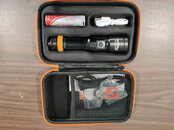Here's another review of the D530UV.
We had a older dive light that included UV as a sort of secondary emitter. It illuminated fluorescent objects pretty well but left us wondering about the "OH WOW" comments we'd read from others about UV night dives.
Then we noticed that OrcaTorch was offering a new UV light, the D530UV. We'd had good experiences with other OrcaTorch lights and thought perhaps it could improve our UV night diving, so we bought one via Amazon and it arrived in a few days.
First, the packaging is very good indeed. Amazon ships it in a exterior cardboard box. Inside that is a white OrcaTorch box, and inside THAT is a very nice hardside zipper case for the light and its accessories:
Needless to say, the light is very well protected!
When you unzip the hardside case, you're greeted by the light itself, a 3400mAH battery, a USB charging cable, a wrist lanyard, spare o-rings, and documentation:
The USB charging cable is meant to be used with the USB port on the side of the battery (visible in the photo above). This is a recent trend in rechargeable batteries where charge-management circuitry is built right into the battery itself. The convenience is unquestionable, but personally I prefer to use an AC powered multicell charger that gives me control over charge rate and allows me to monitor things. For minimalist travel, though, the OrcaTorch battery is hard to beat.
The light unscrews mid-body to access the battery compartment. It is sealed by three o-rings which come pre-greased from the factory, with three spares included. The light is rated to 150 meters, well past recreational depths.
The light body also has an orange "grip ring" made of grippy elastomer. At first we thought this was purely decorative, but during use it really did help to keep the otherwise smooth-exteriored light oriented in your hand.
The light has a single user control - a pushbutton, by far our favorite type of light control. Twist ring switches can trick you into accidentally unscrewing and flooding the battery compartment. The D530UV button is pressed once for full brightness, a second time for roughly half brightness, and a third time to turn it off again. While the light is on the button has an LED indicating the charge state of the battery. Anything other than green or orange means you're getting low on charge.
I've always questioned the use of battery status LED's, since they report how much your battery is discharged by discharging it faster! A better approach might be to flash the indicator 1-5 times indicating charge states of 20-100%. The resulting lower duty cycle would consume less power while conveying more detailed information. Thankfully, in this case it's probably not a big deal since the primary LED is consuming probably two orders of magnitude more current than the button LED.
One more technical detail before we get to the underwater photos. The D530UV's wavelength is specified as 395nm, which is theoretically on the edge of human vision. However, LED's are not perfectly monochromatic and the human eye doesn't have brick-wall wavelength response. The result is that you can indeed see "blue" light when the D530UV is turned on, but the light you're seeing isn't the total intensity of the UV being emitted.
On to what matters: Underwater UV performance! Our next night dives are a couple of months away and we wanted to evaluate the DS530UV ahead of that trip in case it didn't perform as expected. Lacking any naturally fluorescing flora and fauna in our dive tank, we found four children's toys at a local big box store in fluorescent colors (we insured they were truly fluorescent using the DS530UV in the store!). We glued those to a piece of wood, laid it on the bottom of the tank, and held it in place with dive weights. Then we killed the tank lights to create our own private night dive.
Photos were taken with an Olympus TG-6 dive camera, which has a smaller objective lens so light gathering (and thus focus) isn't as good as your own eyes.
Here's the scene with all light extinguished. You can just barely make out our four little "targets":
Our older UV light has a constant-density beam. The new D530UV has a flood pattern with a hotspot in the center. This makes it difficult to compare them directly, but we can get close by comparing the old light with the annular ring of the DS530UV's flood pattern.
This is what our old light presented:
(continued below due to five image limit)


 Great & Compact Dive Light - ORCATORCH UV light will bring the reef to life! The 395nm LED creates an amazing fluorescent effect. The UV light is almost invisible to the naked eye, so only the fluorescent colors are revealed.
Great & Compact Dive Light - ORCATORCH UV light will bring the reef to life! The 395nm LED creates an amazing fluorescent effect. The UV light is almost invisible to the naked eye, so only the fluorescent colors are revealed.
 Multifunctional: Easily detect objects unseen by the naked eye. Such as searching for amber and minerals, revealing dried pet urine stains, odor of other small animals on carpets clothes floor, scorpion hunting, detect fluorescence, money, ID cards, passports and so on.
Multifunctional: Easily detect objects unseen by the naked eye. Such as searching for amber and minerals, revealing dried pet urine stains, odor of other small animals on carpets clothes floor, scorpion hunting, detect fluorescence, money, ID cards, passports and so on.

 Click here to see more details on Amazon
Click here to see more details on Amazon










